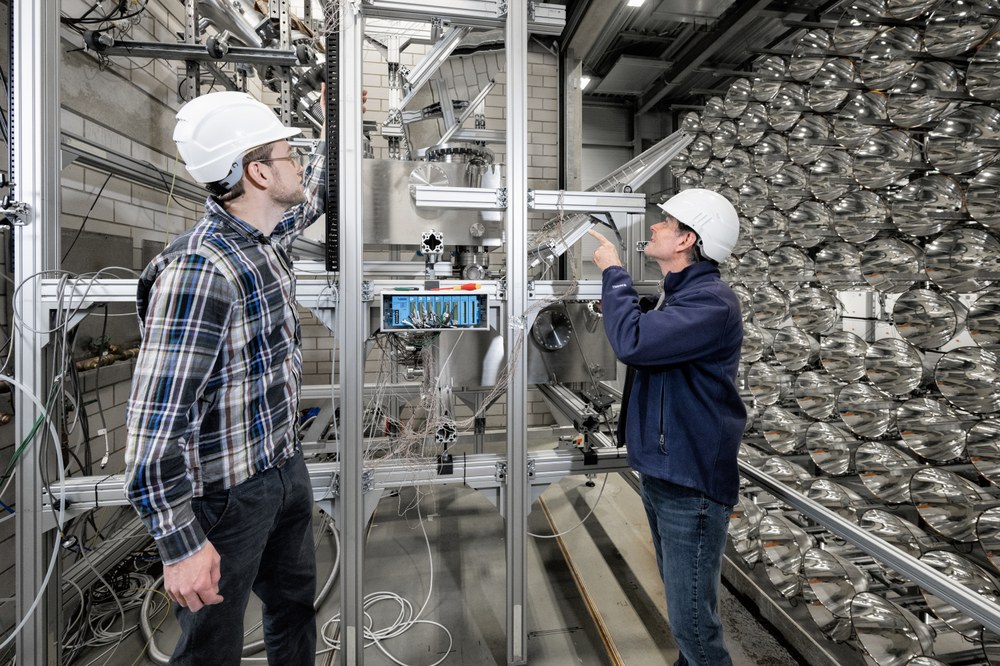HESTHY

Improvement and testing of particle-based solar reactor systems for thermochemical hydrogen, synthesis gas and ammonia production
Duration: April 2020 – July 2023
Together with our US partner Sandia National Laboratories, we are improving a system consisting of two solar vacuum particle receivers in which the first of two process steps for thermochemical hydrogen production is carried out with redox cycle processes. The particle receivers are to be operated at two different vacuum pressures and the pressure separation between them is to be realised via a moving particle bed. An improved receiver design should enable more stable and efficient operation. The system will be set up and tested at DLR's Synlight in Jülich.
Hydrogen is needed in many sectors to replace fossil energy sources or fossil base materials and thus reduce greenhouse gas emissions. For example, it can be used instead of coke as a reducing agent in steel production, as a base material for synthetic fuels in heavy-duty and air transport or as a base material for fertiliser production (ammonia synthesis). Hydrogen also lends itself to the generation of high-temperature heat, for example in the glass industry or as a seasonal storage option in the building sector. However, the use of hydrogen can only reduce emissions if the hydrogen itself is produced with little to no greenhouse gas emissions.

This can be done in an electrolysis process in which water is split electrochemically with the help of electrical energy from renewable sources, for example from photovoltaic systems. Another possibility is to split the water thermochemically using thermal energy. The heat can be provided with low emissions by concentrating solar systems that focus the sunlight with the help of mirrors. Since the conversion step to electrical energy is omitted, thermochemical processes offer potentially high efficiencies.
DLR and the Sandia National Laboratories in the USA are working together to further develop such thermochemical processes and to demonstrate the achievable efficiencies experimentally. In a project completed in 2017, in which other American partners were involved, a prototype for hydrogen production was set up in Albuquerque/New Mexico.
In this prototype, metal oxide particles (in this case cerium oxide, CeO2) are heated to a temperature of 1450 degree Celsius in a solar reactor with the help of concentrated sunlight and release oxygen in the process, i.e. they are reduced. In order to drive more oxygen out of the metal oxide particles, this is done in a vacuum. The particles are then transported to another reactor where they come into contact with water vapour at about 900 degree Celsius and ambient pressure. The reduced particles take up oxygen again, namely from the water molecules in the steam. In this way, the water molecules are split and hydrogen is produced. The oxidised particles are returned to the solar reactor to complete the cycle.

In the first prototype in Albuquerque, the metal oxide particles were heated to over 1400 degree Celsius and hydrogen could be produced. In the current project, the researchers from DLR and Sandia want to further improve the system set up at DLR's Synlight in Jülich. Two solar reactors are now to be operated in series at different vacuum pressures, which promises to increase the efficiency of the reduction step. The pressure separation between the two solar reactors is to be realised via a moving particle bed. The goal is to further improve the solar reactors themselves so that more stable and longer operation is possible and more measurement data can be generated. The project is funded by the US Department of Energy (DOE) and ends in July 2023.



Project | HESTHY |
|---|---|
Duration | April 2020 - July 2023 |
Partners | |
Funding |
